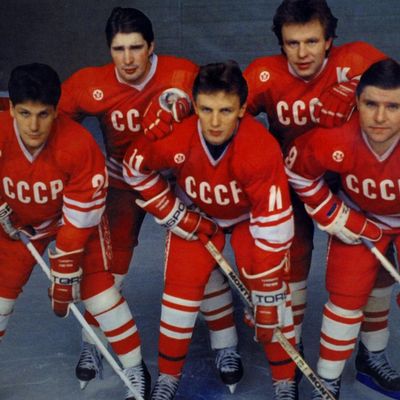
Even some of us non-hockey fans find the story of the “Miracle on Ice” deeply moving. We’ve certainly heard it recounted many, many times — how a scrappy, underdog U.S. team made up of amateurs and college kids defeated the seeming indestructible Soviets at the Lake Placid Olympics in 1980, injecting a much-needed dose of pride to a beaten-down American public and helping popularize hockey overnight. (The event was valorized memorably in the misty Kurt Russell movie Miracle.) Gabe Polsky’s ingenious, touching documentary Red Army looks at the other side of this myth, the seemingly faceless, allegedly robotic players who made up the Soviet team. There, Polsky finds a story even more epic and powerful than the Miracle on Ice.
The film covers the whole swath of Soviet hockey in the 20th century. The USSR saw in the sport an opportunity both to prove dominance on the international stage and to show the selfless, collective Soviet ethos at work. But the heart and soul of the film is Russian defenseman Slava Fetisov, the legendary captain of the Soviet team who would eventually come to play in the United States after much heartbreak and endless double-dealing by officials. Sometimes brusque and impatient, other times garrulous and emotional, the mercurial Fetisov is the kind of interview subject filmmakers dream about, and Polsky knows it; the director lets their charmingly offhand relationship bleed onto the screen, flipped birds and all.
Between the offhand comments by Fetisov, and Polsky’s penchant for relentless visual whimsy, the playful tone of Red Army can be a bit distracting at first. But the film works beautifully once it steers away from the big picture and settles on the players of that storied team from the late ‘70s and ‘80s — talented, proud men who were broken into a life akin to slavery. Under their domineering, party-approved coach Viktor Tikhonov, they were in camp 11 months of the year, holed up in a hotel far from their families, with only each other for company. (Tikhonov’s brutality increased after the loss to the Americans.) That was the cruel toll of their uncommon grace and precise, nervous-system-like coordination.
As the Soviet system started to collapse, these players began to look to the West for opportunities, but not all of them were able to leave so easily. Perhaps the most heartbreaking parts of Polsky’s film involve the years of negotiations, double-crosses, and — at least at one point — beatings that went into Fetisov’s attempts to legally move to the U.S. (He could have defected long before that, but he loved his country too much to do so.) When he did, he was greeted as a curiosity, an over-the-hill Ivan Drago clone meant for mockery. Ironically enough, despite the Russians’ reputations as faceless, unfeeling machines, they found themselves rather out of step with the Westerners’ rough, bruising style of play.
Most hockey fans know what happened next, and part of the delight of Polsky’s film is the way it recounts — through interviews with other players besides Fetisov — the twists and turns of the Soviets’ travails in the U.S. In the end, what emerges from Red Army is not so much a history of Soviet hockey but a cautionary tale about competition — be it athletic, geopolitical, or personal. This is a movie that reminds us that our obsession with victory always carries a human cost.


